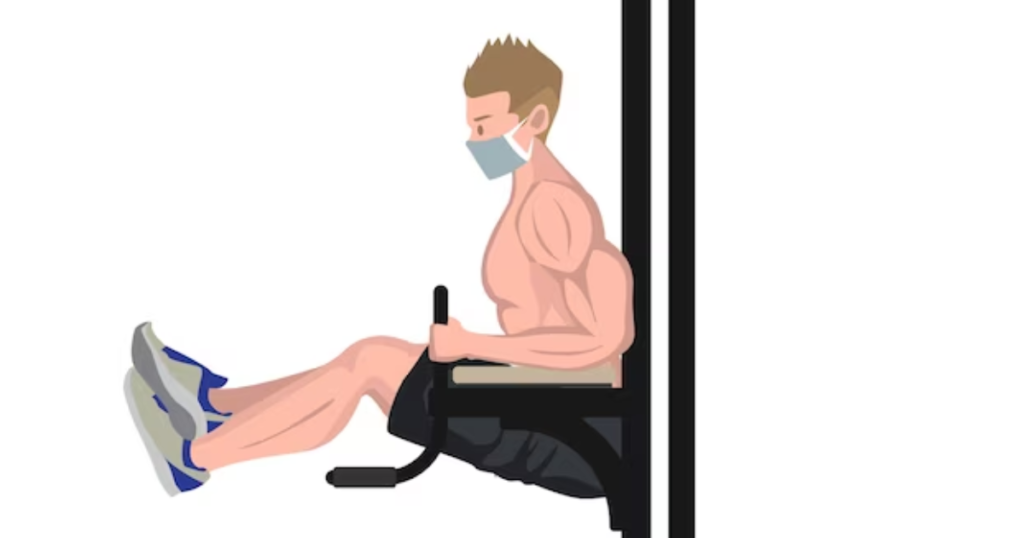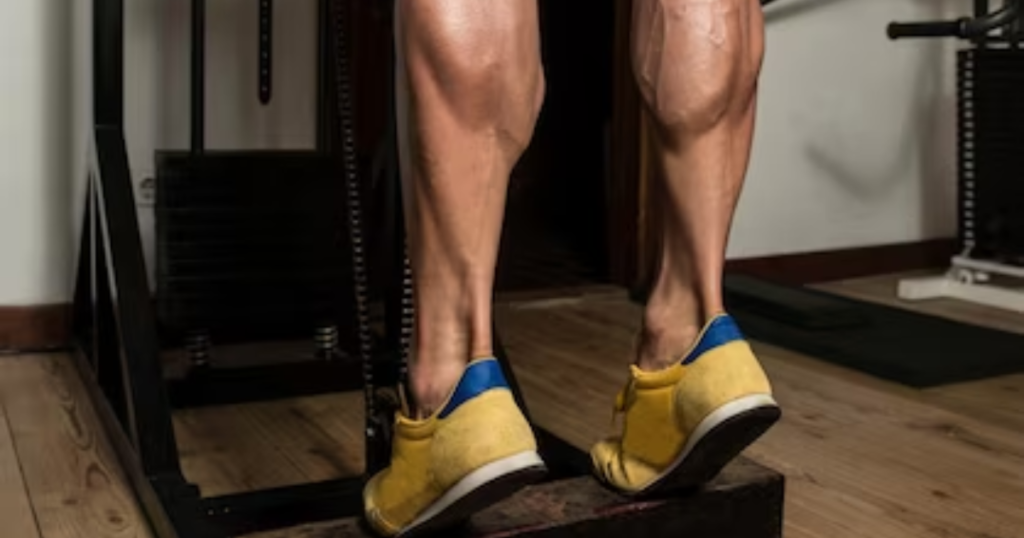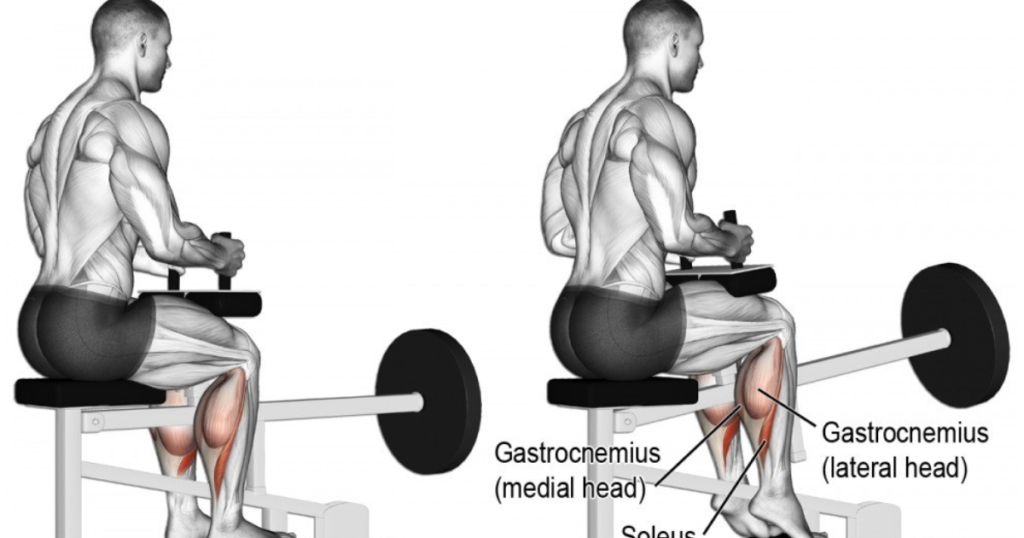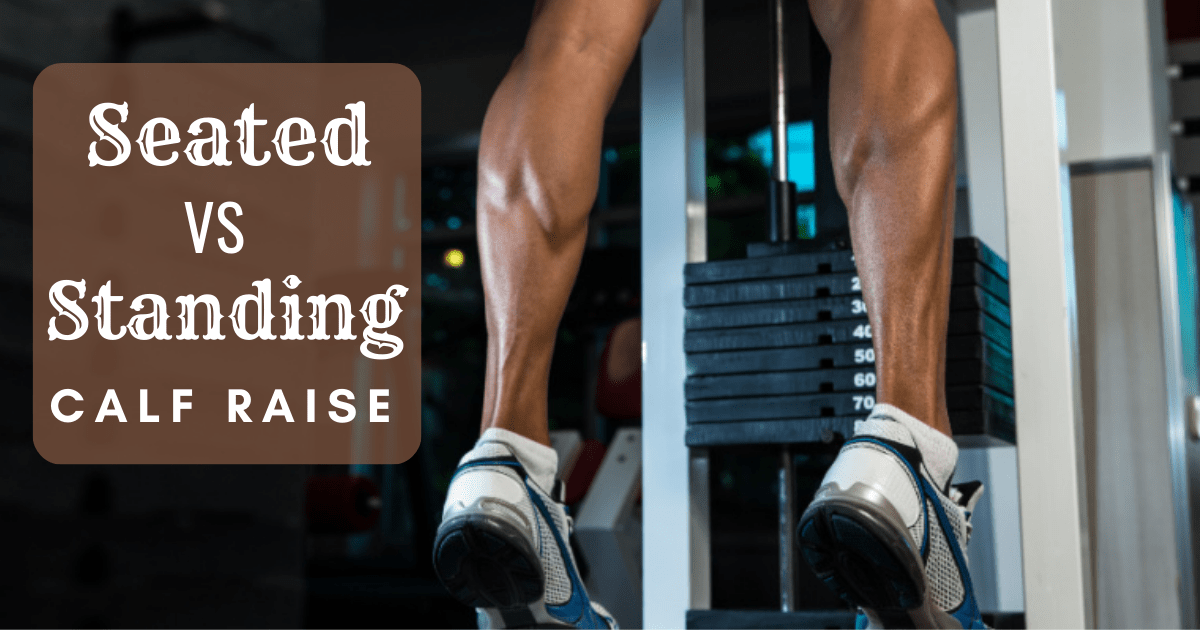Calf raises are a common exercise in lower body workouts that target the calf muscles to improve strength, endurance, and definition. Whether you’re a seasoned gym-goer or just starting out, knowing the distinctions between seated vs standing calf raise will help you optimize your workout regimen and reach your goals.
Calf raises, whether seated or standing, have distinct benefits. Let us break down each one:
- Standing Calf Raise:
- Standing calf raises primarily target the gastrocnemius muscle, located on the outside back of the calf. This muscle provides your calves their unique upside-down heart form.
- Standing calf raises can be performed utilizing a variety of equipment (such a standing calf machine, leg press, squat machine, or Smith machine). Maintaining a straight leg stance is crucial.
- Pros:
- Gastrocnemius Focus: The straight leg calf raise puts significant strain on the gastrocnemius muscle, which contributes to thickness from the side and inside width.
- Cons:
- Bouncing: Avoid bouncing, a common mistake when training calves. Overloading with too much weight and doing half-squats with your knees will not produce optimal results.
- Seated Calf Raise:
- Muscles Targeted: Seated calf raises primarily target the soleus muscle, found beneath the gastrocnemius. The soleus and gastrocnemius share the same function: elevating the heel.
- Execution:
- Sit on a calf raise machine, knees bent.
- Put the balls of your feet on the platform.
- Flex your calves to push the platform upward.
- Pros:
- Thickness: Seated calf raises emphasize thickness, making them great for building strong lower legs.
- Comfort: The seated position is comfortable, with no compressive forces on your spine.
What are Calf Raises
Exercises that mainly work the calf muscles in the lower legs are called calf raises. They entail bringing the heels up off the ground while maintaining the planted toes, then bringing them back down. The calf muscles, which are necessary for motions like walking, sprinting, and jumping, are strengthened by this action. You can perform calf raises using just your body weight or, for a more intense workout, with the use of dumbbells or a calf raise machine. They are frequently incorporated into exercise programmes meant to increase lower leg strength and enhance athletic ability.
Benefits of Calf Raises
Raising your calves has various advantages.
- Calf Muscle Strengthening: The main focus of calf raises is on strengthening the gastrocnemius and soleus muscles, which contribute to increased endurance and strength.
- Enhances Stability and Balance: Calf raises can improve stability and balance by strengthening the lower leg muscles, which is advantageous for a variety of exercises and sports.
- Enhances Athletic Performance: By strengthening the calf muscles through calf raises, one can improve one’s overall athletic performance. Strong calf muscles are necessary for motions like running, jumping, and pushing off the ground.
- Helps Prevent problems: By enhancing the lower legs’ resilience and stability, strengthening the calf muscles can help prevent problems like calf strains and Achilles tendinitis.
- Helps with Rehabilitation: Calf raises are a useful exercise for lower leg injury rehabilitation programmes as they promote the regrowth of muscle and tissue in the calf muscles and surrounding areas.
- Contributes to Aesthetic Development: Strong calf muscles can improve the way the lower limbs look, giving the body a more well-defined and balanced appearance.
- Can Be Done anyplace: Calf raises are a handy exercise to add to a training regimen because they can be done almost anyplace and just require a small amount of equipment.
A thorough training programme that includes calf raises can help people become stronger, more stable, and more physically proficient in their lower legs.
What Muscles are Worked by Calf Raises?
The primary muscles targeted by calf raises are the following:
Gastrocnemius:
The gastrocnemius is the calf’s largest and outermost muscle. It’s the one that gives your lower leg a round and robust appearance, particularly when you stand up and gaze at it from behind. This muscle allows you to point your toes down, as when you stand on tiptoes. When you sit down and do calf raises, you also use this muscle, but not as much as when you stand up. That’s why it’s referred to as both a seated vs standing calf raise. Both workouts work the calf muscles, although in slightly different ways.
Soleus:
Beneath the gastrocnemius muscle lies the soleus, a deeper muscle. It comes from the lower leg’s tibia and fibula bones and aids in the ankle’s plantar flexion.
Although the tibialis anterior, which is positioned at the front of the shin, and other stabilising muscles in the lower leg may also be slightly engaged to maintain balance and control during the exercise, these two muscles are the main muscles worked during calf raises.
What Is A Seated Calf Raise?
A seated calf raise is a variation of standing calf raises, where the individual performs the exercise while seated. The exercise involves setting up a calf raise machine or bench with a platform for feet, positioning hands for stability, and starting with heels lower than the balls of the feet. The exercise involves pushing through the balls of the feet to raise heels as high as possible, contracting the calf muscles at the top, and holding the contraction briefly before slowly lowering the heels back down. Repetitions are typically 8-12, maintaining control and proper form. Seated calf raises target the soleus and are beneficial for individuals with balance or stability issues.

Pros and Cons of Seated Calf Raise
Pros of Seated Calf Raises:
- Isolation of Soleus Muscle: The soleus muscle in the calf is the main target of seated calf raises. particular makes it possible for particular muscle to grow its strength specifically, which is beneficial for activities like walking and maintaining posture.
- Decreased Lower Back pressure: Since the person is seated and supported by the machine or bench, seated calf rises usually cause less pressure on the lower back than standing calf raises. For those who have trouble balancing or with their lower back, this may be helpful.
- Ease of Execution: People with different levels of fitness can perform seated calf raises because they are often easier to perform than standing varieties. Better stability and control are also provided during the activity when seated.
- Variety in Training: Adding seated calf raises to a routine helps keep calf training exercises interesting and avoids training plateaus.
Cons of Seated Calf Raises:
- Restricted Range of Motion: Compared to standing versions, seated calf raises may have a smaller range of motion, which may reduce the exercise’s ability to properly engage the calf muscles.
- Decreased Gastrocnemius Activation: While sitting calf rises mainly work the soleus muscle, they may not activate the gastrocnemius muscle to the same degree as standing calf raises, which could hinder the development of the calf as a whole.
- Dependency on Equipment: Not all gyms or home workout setups have access to specialised equipment, such as a calf raise machine or bench, which is frequently needed for seated calf rises.
- Less Functional Strength: Compared to standing variations, sitting calf raises may not transfer as well to functional motions and tasks that call for dynamic balance and stability. However, they can still assist strengthen the calf muscles.
What Is A Standing Calf Raise?
A standing calf raise is a strength training exercise that targets the gastrocnemius and soleus calf muscles. It involves lifting the heels off the ground while standing and then lowering them back down. To perform, stand tall with feet hip-width apart, keeping your core engaged and shoulders relaxed. Position on the floor or on an elevated surface, with feet on the edge. Execute slowly, lifting the heels off the ground and contracting the calf muscles at the top. Lower the heels back down, allowing a full stretch. Repeat for 8-12 repetitions, maintaining control and proper form. Variations include different foot positions and added resistance like dumbbells or a calf raise machine. Standing calf raises are effective for building strength, endurance, and size in the calf muscles.

Pros and Cons of Standing Calf Raises
Pros of Standing Calf Raises:
- Works All of the Calf Muscles: Standing calf raises work the gastrocnemius and soleus muscles, working every muscle in the calf complex.
- Functional Strength: This workout is very useful to both everyday activities and athletics because it replicates the movements used when walking, running, and jumping.
- Better Balance and Stability: Because standing calf raises require maintaining equilibrium while lifting and lowering the body weight, they contribute to the development of balance and stability.
- Versatility: People who exercise at home or at the gym can practice standing calf raises almost anyplace with the least amount of equipment.
Cons of Standing Calf Raises:
- Greater Lower Back Strain: Standing calf raises may cause more pressure on the lower back than seated calf raises, especially if good technique is not maintained or high weights are used.
- Limited Range of Motion: Some people may struggle to reach complete range of motion, particularly if they have tight calf muscles or limited ankle flexibility.
- Overloading: Without adequate progression and technique, there is a risk of overworking the calf muscles or exacerbating existing ailments, such as Achilles tendinitis or calf strains.
- Requires Balance and Coordination: Standing calf raises need a certain amount of balance and coordination, which may be difficult for beginners or those who have balance concerns.
Muscles Targeted in Seated Calf Raises
Seated calf raise vs standing calf raise are two types of exercises that assist strengthen your calves. When you execute seated calf raises, you primarily work the soleus muscle in your calf. This muscle is located deep beneath the gastrocnemius. Seated calf lifts are more effective at targeting the soleus muscle than standing calf raises. That’s why they’re ideal for targeting a certain muscle. The gastrocnemius gets a workout during seated calf raises, although not as much as the soleus. During seated calf raises, other muscles in your lower leg may contribute to the movement, but the soleus muscle receives the majority of the attention.
Muscles Targeted in Standing Calf Raises
Standing calf raises target two main muscles in the calf region: the gastrocnemius, a larger, superficial muscle responsible for plantar flexion of the ankle, and the soleus, a deeper muscle beneath it. These muscles work together to lift the body’s weight onto the feet’s balls, providing strength, stability, and power for movements like walking, running, and jumping. Stabilizing muscles in the lower leg may also be engaged to support the movement and maintain balance. The gastrocnemius is more actively engaged in standing calf raises.
Difference Between Seated and Standing Calf Raises
The key variations between seated and standing calf raises are the position of the body and the specific muscles targeted.
- Body Position: In seated calf rises, the individual sits with their knees bent at around 90 degrees, whereas in standing calf raises, the individual stands erect with their legs straight.
- Muscles Targeted: Seated calf raises primarily work the soleus muscle, which is deeper and placed beneath the gastrocnemius. Standing calf raises work both the gastrocnemius and soleus muscles, with the gastrocnemius being more active due to the stretched posture of the ankle.
- Range of Motion: Standing calf rises often provide a wider range of motion than seated calf raises since the user may completely extend the ankle joint when lifting the heels off the ground. Because of the seated position and knee angle, seated calf raises may have a smaller range of motion.
- Lower Back Involvement: Seated calf rises put less strain on the lower back than standing calf raises because the individual is supported by the seat and does not have to maintain balance while rising the heels.
- Stability and Balance: Standing calf rises need greater balance and stability than seated calf raises since the individual has to hold their body weight on the balls of their feet while standing. Seated calf raises provide a more firm basis, making it appropriate for people who have balance concerns or are recovering from lower-body ailments.
Overall, both seated vs standing calf raise are good calf muscle exercises, although the advantages and considerations vary depending on individual needs and preferences.

Comparing Intensity and Resistance
The seated vs standing calf raise are separate exercises. A sitting calf raise allows you to better manage how much weight you use. This makes it suitable for novices or those recovering from an injury. However, standing calf raises require more balance and stability. This might cause your muscles to work harder.
Variations and Modifications
Machine vs. Free Weights
Calf raises can be performed seated or standing, with machines or free weights. Machines provide greater stability and control than free weights, which demand more balance and coordination.
Single-Leg vs. Both Legs
Calf raises can be done with both legs at once or one leg at a time for increased challenge and balance training.
Common Mistakes to Avoid
When practicing calf raises, whether seated or standing, it is critical to avoid frequent mistakes in order to maximise performance and limit injury risk. Here are some common mistakes you should avoid:
- Using Momentum: Avoid using momentum to lift your heels during calf lifts. To properly engage the calf muscles, use controlled actions such as carefully rising and lowering the heels.
- Incomplete Range of Motion: Make sure you have a complete range of motion during calf lifts. Lower the heels as far as is comfortable to fully stretch the calf muscles, then raise them as far as possible to fully contract the calf muscles at the top of the action.
- Poor Posture: Keep a proper posture during the activity. Keep your back upright, shoulders back, and core engaged to avoid straining your lower back or other muscles.
- Rounding the Shoulders: Avoid rounding your shoulders forward while performing calf lifts. To ensure good spine alignment and support, keep your shoulders back and your chest raised.
- Neglecting Foot location: During calf rises, pay attention to the location of your feet. Make sure your feet are parallel to each other and your weight is evenly distributed between the balls of your feet.
- Overloading with Weight: When utilising additional resistance, such as dumbbells or a calf raise machine, avoid using excessive weight. Begin with lesser weights and gradually increase resistance as your strength grows to avoid straining your muscles or joints.
Avoiding these frequent faults and focusing on appropriate form and technique will result in a safe and effective calf raise workout that focuses the calf muscles while reducing the chance of injury.
Incorporating Both Into Your Routine
Incorporating both physical activity and mental stimulation into your daily routine is critical for general health. Here’s how you can combine the two seamlessly:
- Morning Exercise with Mindfulness: Begin the day with a brisk walk, jog, or yoga session. Practice mindfulness while exercising by paying attention to your breathing and body sensations. This combination of physical activity and mental presence establishes a favourable tone for the day ahead.
- Learning While Working Out: Listen to podcasts, audiobooks, or informative lectures as you exercise. Whether you’re on the treadmill, lifting weights, or going for a run, feeding your head with fresh information improves both your workout and cerebral stimulation.
- Lunchtime Brain Boost: During your lunch break, do tasks that challenge your intellect. This could be solving puzzles, reading articles on interesting topics, or even taking online courses to master a new skill. Take advantage of this opportunity to exercise both your head and your body.
- Afternoon Active Breaks: Include short bursts of physical activity during the afternoon. Set reminders to stretch, practise some yoga positions, or go for a brisk walk around your workplace. These breaks not only rejuvenate your body, but also help you focus and be more productive.
- Evening Relaxation and Reflection: End your day with peaceful activities that engage your mind in a new way. This could include journaling, meditation, or creative activities such as painting or playing a musical instrument. Reflect on your day, make goals for tomorrow, and allow your brain to decompress.
Doing workouts like seated vs standing calf raise and exercising your brain with puzzles or learning new things every day not only benefits your body but also your mind. This improves your mood and cognitive function, making life more enjoyable and balanced.
Read More: Top 9 Lat Workouts with Dumbbells
Which One Is Better for You?
Calf raises can help make your lower legs stronger and keep your ankles stable. There are two ways to do them: sitting down or standing up. Each way has its own benefits. If you know the difference between seated vs standing calf raise and do them both in your exercise routine, you can make your calf muscles bigger and also lower the chance of getting hurt.
Frequently Asked Questions
What are the differences between seated and standing calf raises?
Standing calf raises are performed by standing up straight and elevating your heels off the ground with your calf muscles. Seated calf raises include sitting down and elevating a weight with your calf muscles while pushing against resistance.
Which is best for developing calf muscles?
Both seated and standing calf raises can assist increase calf muscles, but they focus on different areas of the calf. Standing calf rises engage the entire calf muscle, whereas sitting calf raises focus on the soleus muscle beneath the calf. It’s beneficial to incorporate both within your workout programme for balanced development.
Are seated calf raises easier than standing ones?
Seated calf raises may seem simpler for some people because you’re sitting down, but they can still be difficult if you use enough weight. Standing calf raises demand you to balance your body, which can make them feel more challenging, especially if you’re lifting large weights.
Can I do seated and standing calf raises during the same workout?
Yes, you can perform both seated and standing calf raises in the same workout. It’s an excellent approach to target your calf muscles from many angles while ensuring balanced development. Just make sure to relax your muscles in between sessions and listen to your body.
Do seated and standing calf raises aid with anything other than developing calf muscles?
Yes, in addition to increasing calf muscles, seated and standing calf raises can enhance ankle stability and strength, which is useful for sports such as running, leaping and even walking. Strong calf muscles and ankles can also aid to avoid injuries in sports and everyday life. So, keep rearing the calves!









Leave a Reply